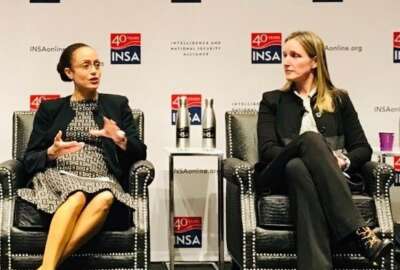
Intelligence community is calling on AI to ease work on analysts
The new program is working with four companies to build a program to look for changes on the earth's surface.
The DoD Reporter’s Notebook is a weekly summary of personnel, acquisition, technology and management stories that may have fallen below your radar during the past week, but are nonetheless important. It’s compiled and published each Monday by Federal News Network DoD reporters Jared Serbu and Scott Maucione.
IARPA working on AI satellite imagery solutions
The intelligence community awarded four contracts to build out a program that will allow artificial intelligence to tag and track satellite images.
The Space-based Machine Automated Recognition Technique (SMART) is an undertaking by the Intelligence Advanced Research Projects Activity — the IC’s high risk, high reward research arm.
“The goal of the SMART program is really to cut through what amounts to an avalanche of satellite imagery that’s coming down, being collected and analyzed,” Jack Cooper, a program manager at IARPA, told Federal News Network. “Our goal is to automate part of that process. We want to automate the broad area search and detection and characterization of larger evolving events.”
IARPA hopes by using AI to monitor things like heavy construction and crop growth that SMART can free up more time for analysts to focus on deeper work.
“There’s simply not enough analysts to look at all the data that that comes down,” Cooper said. Automation enhances our capability because we’re now touching that data. We are getting some coverages not perhaps, to the level of a true subject matter expert’s eyeballs on detailed analysis, but it is enough to understand and tag that for perhaps future review. The Earth is a huge place and we have lots of different satellites collecting data on it. With automation suddenly those places that maybe we weren’t checking and frequently were lower in the in the queue, now they’re a part of the analysis too. We are really enhancing that capability by expanding the swath of area we have knowledge on what we’re staying up to date on.”
IARPA awarded contracts to Accenture Federal Services, BlackSky Geospatial Solutions, Kitware and Systems and Technology Research. The contracts are multiyear and multiphase to allow the companies to build out different ways to tag the information.
“The goal of IARPA is to prove out that concept, and ultimately transition it to a partner or another agency into a program of record and in those regards, but this is a three phase program lasting four years,” Cooper said. — SM
Service members get permanent perk on moving reimbursements
Service members who want to hire their own movers when changing locations for military orders saw the reimbursement rate from the government increase to 100% early in the COVID-19 pandemic. That perk is now permanent.
U.S. Transportation Command put out guidance on Jan. 1, stating that all troops who hire their own private movers can get the Defense Department to pay the full price even after the coronavirus pandemic is over.
The change gives military families more options when moving, especially at a time when the military’s household goods reputation has been less than stellar. Families reported missing and broken goods. TRANSCOM is in the process of revamping its household goods contract to make companies hired by the military more accountable and improve service. However, the contract is in its nascent stages.
Before the coronavirus pandemic, families were only reimbursed 95% of the best value cost when hiring private movers.
In late May, DoD decided to give families the extra 5% to help out with economic issues and moving problems caused by COVID.
Moving is still a complicated situation for the military during the pandemic. As of Jan. 18, 63% of military bases had travel restrictions. That translates to about 150 bases limiting travel. Those limits include service members needing waivers to move to new orders to restrictions on how far troops can go from their installations.
Air Force eases hair restrictions
Women airmen now have more options for how they can wear their hair after the Air Force reviewed its grooming standards last week.
Longer ponytails and braids are now accepted in the service. Women can wear a single braid or ponytail or double braids down to the top inseam of their sleeves.
The moves comes after reports of damaged hair, headaches and even hair loss for some airmen due to the previous grooming standards. Recommendations for new standards came from thousands of women across the force to the 101st Air Force uniform board, which convened last November.
The changes will go into effect in February.
“This decision is a commitment to supporting the airmen we need and sustaining the culture and environment of excellence that will continue to make the Air Force an attractive career choice for airmen and families,” said Air Force Chief of Staff Gen. C.Q. Brown. “I’m thankful for the feedback and research conducted from a number of women leaders, the Women’s Initiative Team, the Air Force uniform board, and our joint teammates.”
The Air Force and other services have recently been rethinking their grooming standards that have negatively affected certain cultures or people with specific health issues.
“In addition to the health concerns we have for our Airmen, not all women have the same hair type, and our hair standards should reflect our diverse force,” said Chief Master Sergeant of the Air Force JoAnne Bass. “I am pleased we could make this important change for our women service members.”
Last year, the Air Force published guidance allowing airmen prone to razor bumps to grow short beards. The same guidance also allowed airmen to wear turbans and hijabs. — SM
Copyright © 2024 Federal News Network. All rights reserved. This website is not intended for users located within the European Economic Area.
Scott Maucione is a defense reporter for Federal News Network and reports on human capital, workforce and the Defense Department at-large.
Follow @smaucioneWFED
Related Stories





